Fixed Particle Size Ratio Pure Copper Metal Powder Molding Fine Simulation Analysis
Abstract
1. Introduction
2. Simulation Method and Conditions
2.1. Geometric Modeling
2.2. Validation of Model Validity and Mesh Independence Analysis
3. Results and Discussion
4. Conclusions
Author Contributions
Funding
Data Availability Statement
Conflicts of Interest
References
- Wang, W.; Weng, M.; Dong, K.; Qi, H.; Zhao, Y.; Chang, H.; Wang, W.; Liu, P. A study on the simulation of metal powder molding based on the discrete element method with equal particle size. AIP Adv. 2025, 15, 065206. [Google Scholar] [CrossRef]
- Kaščák, Ľ.; Varga, J.; Bidulská, J.; Bidulský, R.; Kvačkaj, T. A Review of Simulation Tools Utilization for the Process of Laser Powder Bed Fusion. Materials 2025, 18, 895. [Google Scholar] [CrossRef]
- Chen, C.; Huang, B.; Liu, Z.; Li, Y.; Zou, D.; Liu, T.; Chang, Y.; Chen, L. Additive manufacturing of WC-Co cemented carbides: Process, microstructure, and mechanical properties. Addit. Manuf. 2023, 63, 103410. [Google Scholar] [CrossRef]
- Wang, W.C.; Liu, P.A.; Qi, H.; Liu, J.J.; Liu, T.Y.; Zheng, L. Finite element analysis of densification of Fe-40at%Al composite powders. AIP Adv. 2019, 9, 015311. [Google Scholar] [CrossRef]
- Liu, Z.; Zhang, L.M.; Ma, A.L.; Ren, D.C.; Ji, H.B.; Zheng, Y.G. Optimizing the comprehensive properties of PBF-LB/M Ti6Al4V alloy in nitric acid by heat treatment. npj Mater. Degrad. 2025, 9, 41. [Google Scholar] [CrossRef]
- Sun, R.; Mi, G.; Huang, X.; Sui, N. Molecular dynamic simulations of Ti–6Al and Fe–12Cr alloys for their heat transfer and oxygen transport behaviors. Mod. Phys. Lett. B 2024, 38, 2350263. [Google Scholar] [CrossRef]
- Pan, X.; Su, H.; Liu, X.; Hong, Y. Multi-scale fatigue failure features of titanium alloys with equiaxed or bimodal microstructures from low-cycle to very-high-cycle loading numbers. Mater. Sci. Eng. A 2024, 890, 145906. [Google Scholar] [CrossRef]
- Chen, H.; Liu, Y.; Li, Y.; Cao, Z.; Chai, Z. A Study of Mechanical Properties of the Iron-base Sintered Steel Adding Fine Cr-Fe Powder. Rare Met. Mater. Eng. 2011, 40, 5–8. [Google Scholar]
- Fu, H.; Zhou, X.; Xue, H.; Li, X.; Lu, K. Breaking the purity-stability dilemma in pure Cu with grain boundary relaxation. Mater. Today 2022, 55, 66–73. [Google Scholar] [CrossRef]
- Liu, Y.; Zhang, J.; Niu, R.; Bayat, M.; Zhou, Y.; Yin, Y.; Tan, Q.; Liu, S.; Hattel, J.H.; Li, M.; et al. Manufacturing of high strength and high conductivity copper with laser powder bed fusion. Nat. Commun. 2024, 15, 1283. [Google Scholar] [CrossRef]
- Qu, S.; Ding, J.; Fu, J.; Fu, M.; Zhang, B.; Song, X. High-precision laser powder bed fusion processing of pure copper. Addit. Manuf. 2021, 48 Part A, 102417. [Google Scholar] [CrossRef]
- Chen, J.; Li, L.; Zhu, Z.; Luo, Z.; Tang, W.; Wang, L.; Li, H. Bioinspired design of highly sensitive flexible tactile sensors for wearable healthcare monitoring. Mater. Today Chem. 2022, 23, 100718. [Google Scholar] [CrossRef]
- Muktadir, M.; Yi, S.; Elliott, A.M. Design of robot grippers for binder jet products handling. Sci. Rep. 2024, 14, 5750. [Google Scholar] [CrossRef]
- Kaščák, Ľ.; Varga, J.; Bidulská, J.; Bidulský, R. Simulation of 316L Stainless Steel Produced the Laser Powder Bed Fusion Process. Materials 2023, 16, 7653. [Google Scholar] [CrossRef]
- Zhao, H.; Zhao, C.; Xie, W.; Wu, D.; Du, B.; Zhang, X.; Wen, M.; Ma, R.; Li, R.; Jiao, J.; et al. Research Progress of Laser Cladding on the Surface of Titanium and Its Alloys. Materials 2023, 16, 3250. [Google Scholar] [CrossRef] [PubMed]
- Ward, A.A.; Palmerio, N.E.; Hareland, C.A.; Cordero, Z.C. Macroscopic yielding and particle-scale densification mechanisms in ultrasonic powder compaction. J. Mech. Phys. Solids 2022, 167, 105011. [Google Scholar] [CrossRef]
- Li, Y.; Belyavsky, O.G.; Gheybi, S.H.; Yaghmazadeh, M.; Hu, T.; Mokarram, N.H.; Chen, M. Densification and Metallurgical Bonding in Copper Powder Compact during Ultrasonic Powder Consolidation; Northeastern University: Boston, MA, USA, 2015. [Google Scholar]
- Sun, R.; Mi, G. Influence of alloying elements content on high temperature properties of Ti–V–Cr and Ti–Al–V series titanium alloys: A JMatPro Program Calculation Study. J. Phys. Conf. Ser. 2023, 2639, 012019. [Google Scholar] [CrossRef]
- Dhami, H.S.; Panda, P.R.; Viswanathan, K. Production of powders for metal additive manufacturing applications using surface grinding. Manuf. Lett. 2022, 32, 54–58. [Google Scholar] [CrossRef]
- Pan, X.; Hong, Y. High-cycle and very-high-cycle fatigue of an additively manufactured aluminium alloy under axial cycling at ultrasonic and conventional frequencies. Int. J. Fatigue 2024, 185, 108363. [Google Scholar] [CrossRef]
- Chandra, S.; Wang, C.; Tor, S.B.; Ramamurty, U.; Tan, X. Powder-size driven facile microstructure control in powder-fusion metal additive manufacturing processes. Nat. Commun. 2024, 15, 3094. [Google Scholar] [CrossRef]
- Zhou, K.; Cui, D.; Chai, Z.; Zhang, Y.; Yang, Z.; Zhu, C.; Wang, Z.; Li, J.; Wang, J. In-situ tailoring microstructures to promote strength-ductility synergy in laser powder bed fusion of NiCoCr medium-entropy alloy. Addit. Manuf. 2023, 66, 103443. [Google Scholar] [CrossRef]
- Xu, X.; Wang, X.; Zhang, M.; Zhang, J.; Tan, J. A parallelized hybrid N-S/DSMC-IP approach deve adaptive structured/unstructured overlapping grids for hypersonic transitional flows. J. Comput. Phys. 2018, 371, 409–433. [Google Scholar] [CrossRef]
- Li, B.; Li, Q. Coupled FEM-DEM modeling of permeability evolution in rough fractured shale during shearing under varying confining pressures. J. Rock Mech. Geotech. Eng. 2025, in press. [CrossRef]
- Zhong, J.; Han, F.; Zhang, L. Accelerated Peridynamic Computation on GPU for Quasi-static Fracture Simulations. J. Peridyn. Nonlocal. Model 2024, 6, 206–229. [Google Scholar] [CrossRef]
- Yang, D.; Jiang, H.; Liu, Y.; Lai, Z.; Liao, M.; Qu, N.; Han, Y.; Zhu, J. Parameters prediction of hot-pressing sintering of high entropy alloys using numerical modeling and simulation. Procedia Manuf. 2019, 37, 529–536. [Google Scholar] [CrossRef]
- Yanov, D.V.; Zelepugin, S.A. Simulation of dynamic channel angular pressing of copper samples using experimental data of loading. J. Phys. Conf. Ser. 2019, 1214, 012023. [Google Scholar] [CrossRef]
- Wang, W.C.; Qi, H.; Liu, P.A.; Zhao, Y.B.; Chang, H. Numerical simulation of densification of Cu-Al mixed metal powder during axial compaction. Metals 2018, 8, 537–561. [Google Scholar] [CrossRef]
- Sun, R.; Mi, G. Investigations on The surface temperature field of Ti–6Al and Ti–48Al alloy under continuous laser ablation. Rare Met. Mater. Eng. 2024, 53, 2405–2412. [Google Scholar]
- Wang, W.; Zhao, Y.; Weng, M.; Dong, K.; Qi, H.; Wang, W.; Li, C. DEM-FEM Simulation of Double Compaction of Cu and Al Composite Metal Powders with Multiple Particle Sizes. Crystals 2025, 15, 526. [Google Scholar] [CrossRef]
- Ganesan, V.V.; Amerinatanzi, A.; Jain, A. Discrete Element Modeling (DEM) simulations of powder bed densification using horizontal compactors in metal additive manufacturing. Powder Technol. 2022, 405, 117557. [Google Scholar] [CrossRef]
- Uranchimeg, K.; Jargalsaikhan, B.; Eui, L.S.; Choi, H. DEM simulation and characterization of copper and iron powders fabricated by ball milling. Particuology 2024, 94, 96–108. [Google Scholar] [CrossRef]
- Gou, D.; An, X.; Yang, R. DEM investigation of the effect of particle breakage on compact properties. EPJ Web Conf. 2021, 249, 07004. [Google Scholar] [CrossRef]
- Ghorbani-Menghari, H. Optimizing powder compaction for enhanced relative density: Insights from multi-particle finite element simulations and genetic algorithm. Mater. Res. Proc. 2024, 41, 2554–2561. [Google Scholar] [CrossRef]
- Güner, F.; Cora, Ö.N.; Sofuoğlu, H. Numerical modeling of cold powder compaction using multi particle and continuum media approaches. Powder Technol. 2015, 271, 238–247. [Google Scholar] [CrossRef]
- Akisanya, A.R.; Cocks, A.C.F.; Fleck, N.A. The yield behaviour of metal powders. Int. J. Mech. Sci. 1997, 39, 1315–1324. [Google Scholar] [CrossRef]
- Faruk Güner, Hasan Sofuoglu, Ömer Necati Cora, An investigation of contact interactions in powder compaction process through variable friction models. Tribol. Int. 2016, 96, 1–10. [CrossRef]
- Martin, C.L.; Bouvard, D.; Shima, S. Study of particle rearrangement during powder compaction by the Discrete Element Method. J. Mech. Phys. Solids 2003, 51, 667–693. [Google Scholar] [CrossRef]
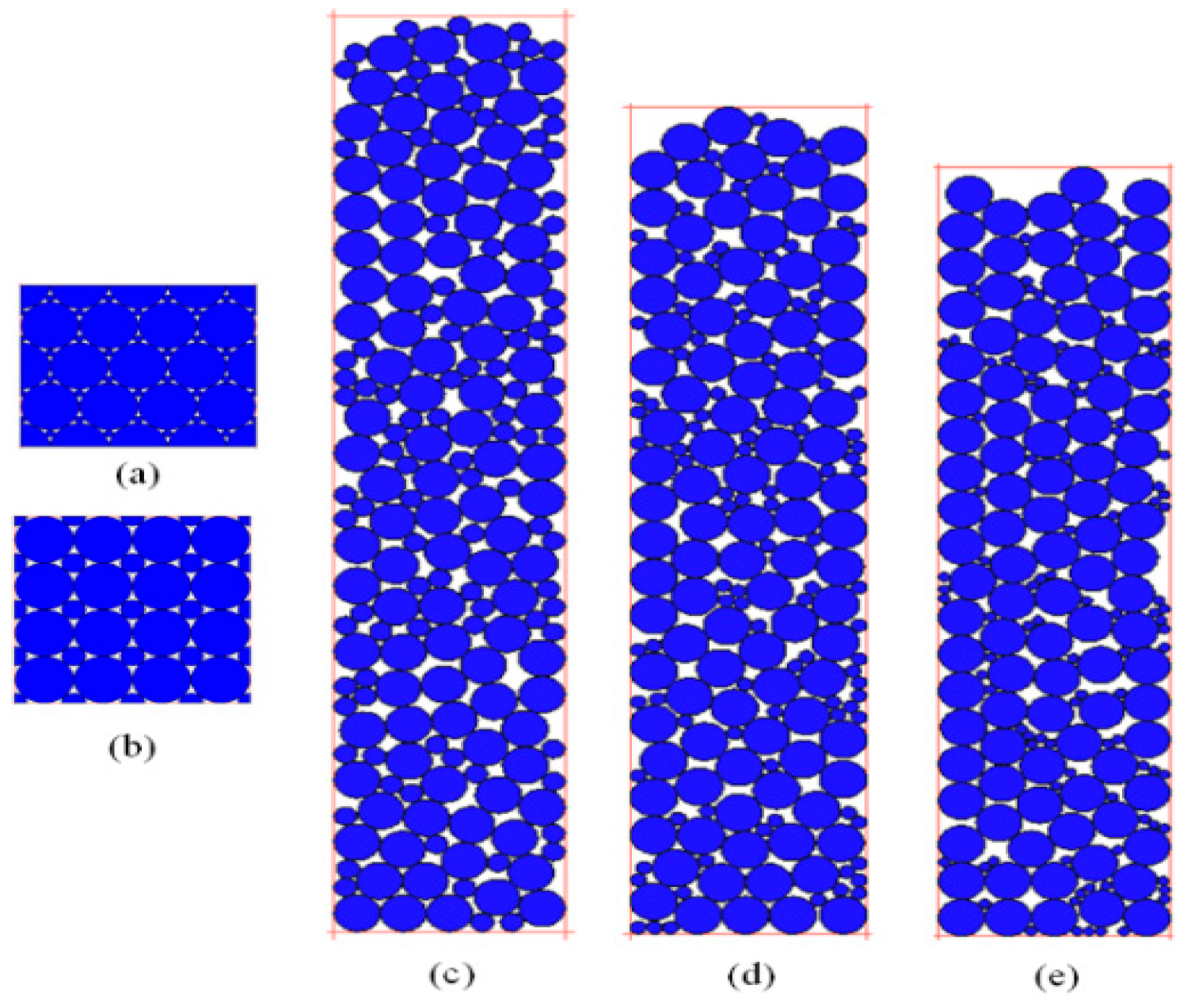
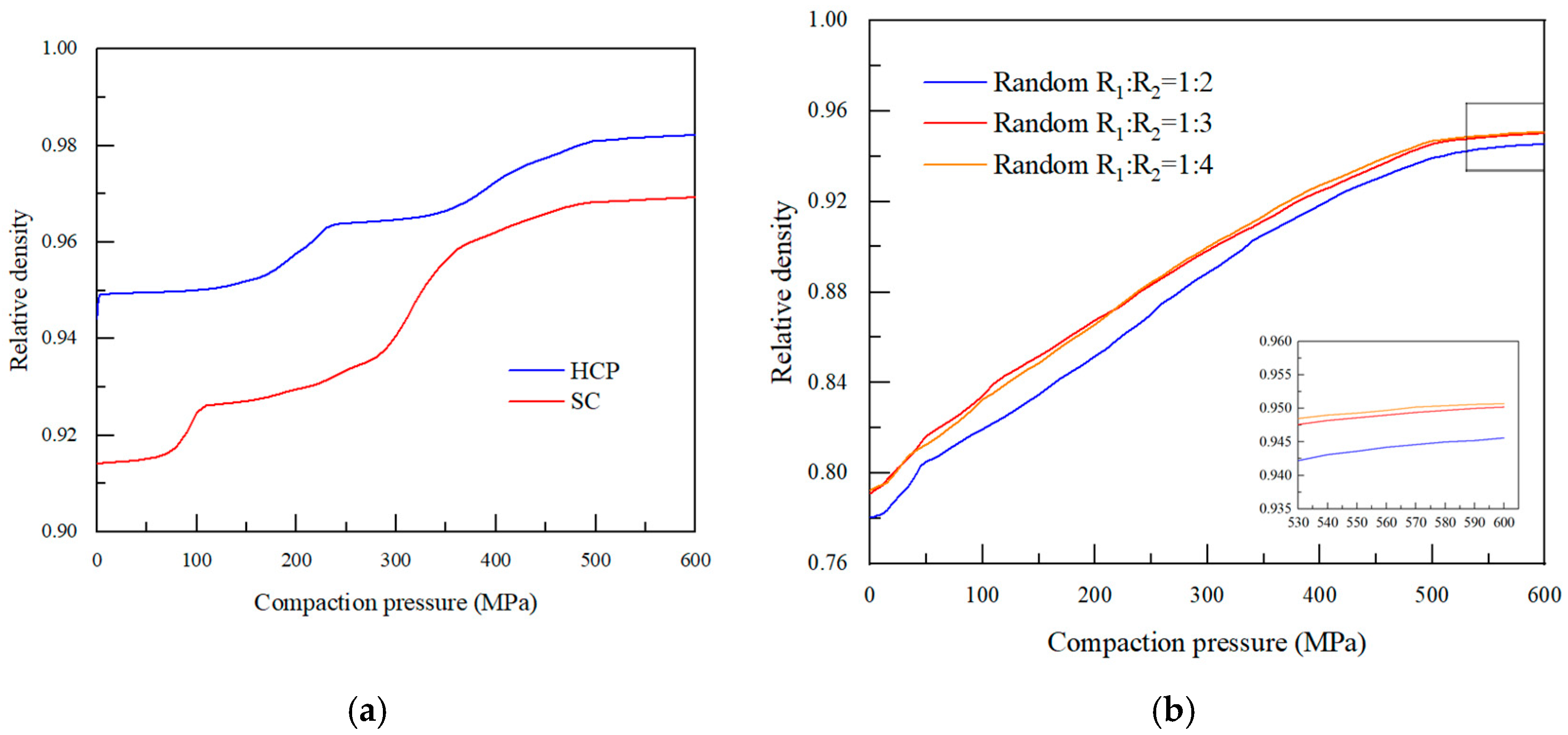
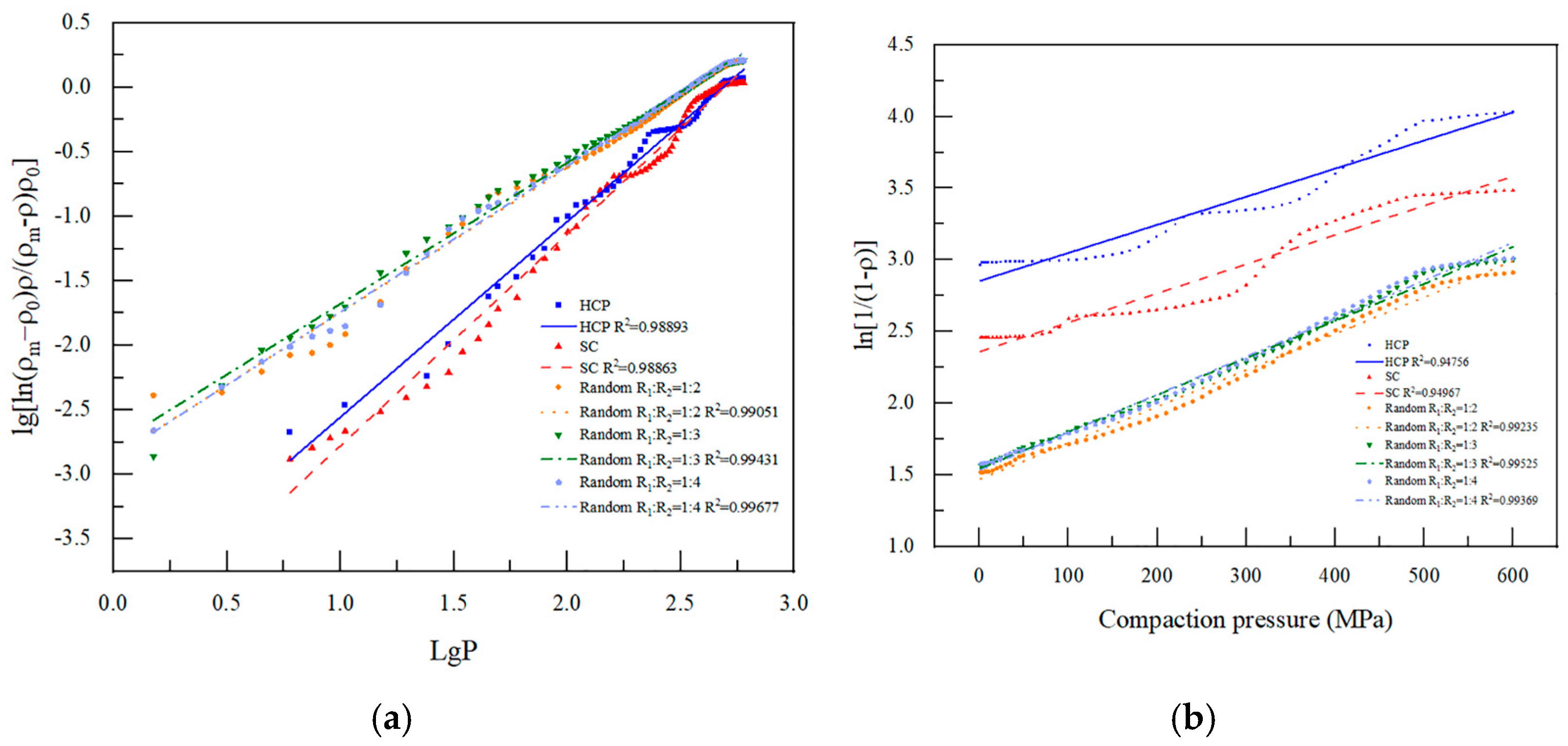
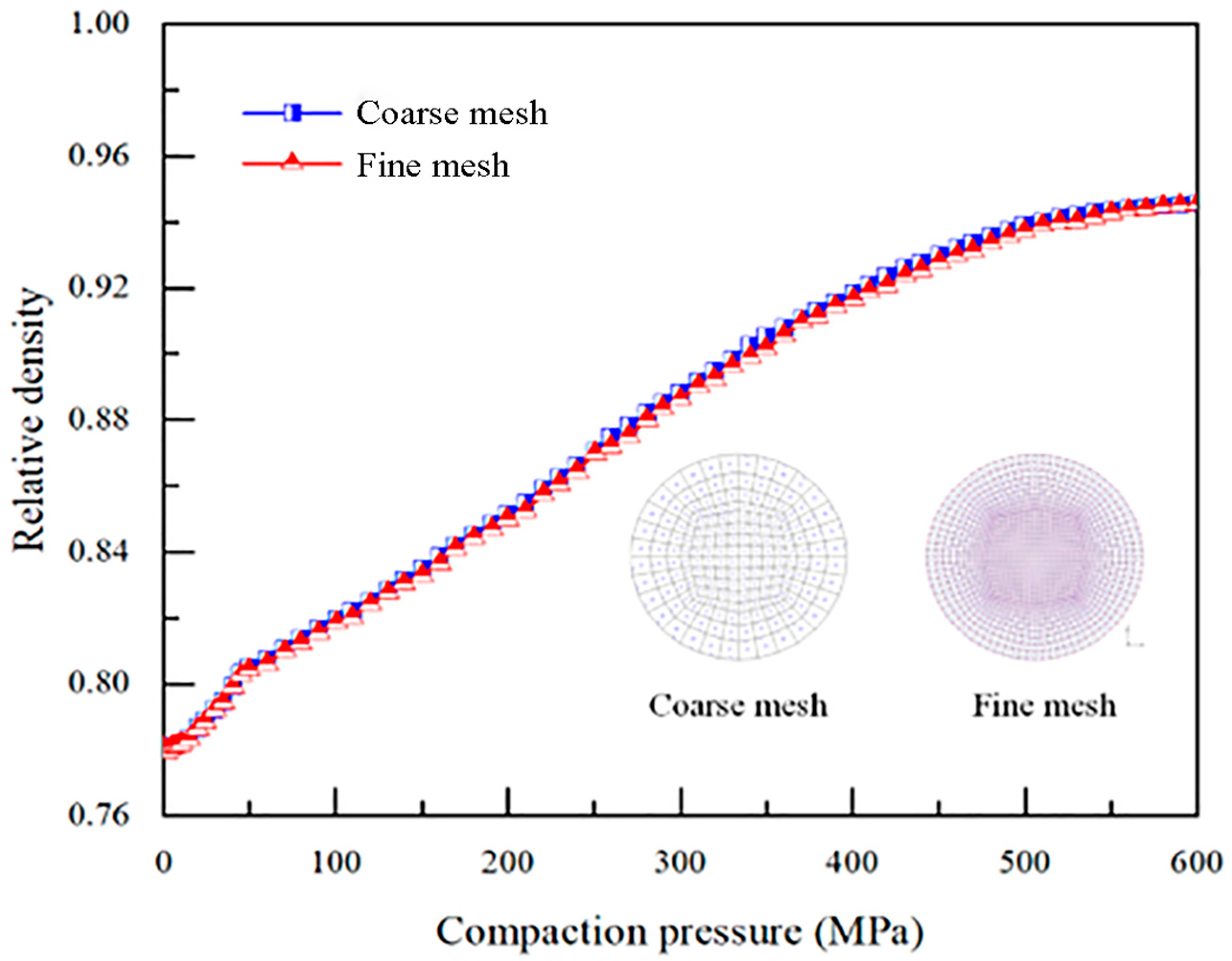

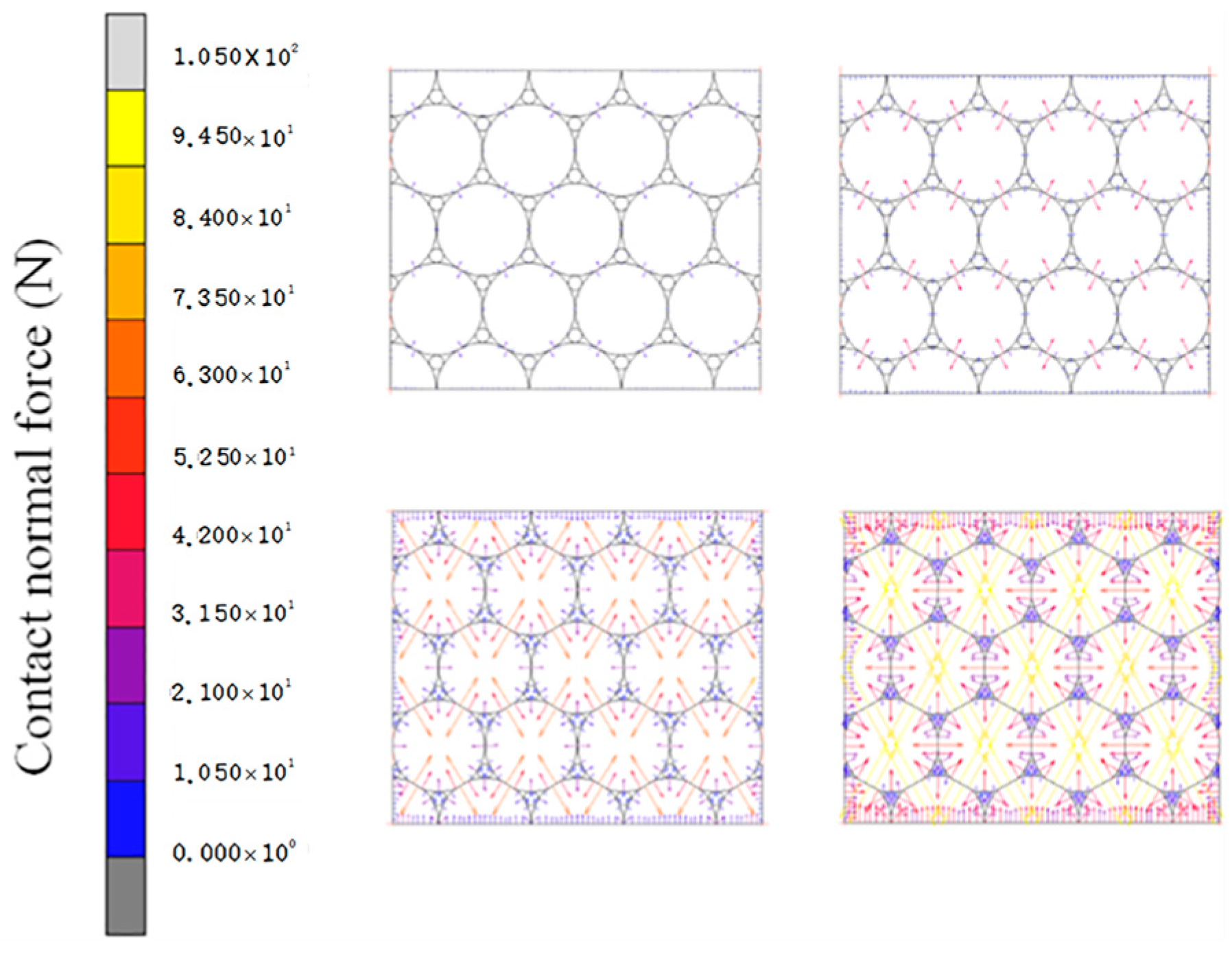


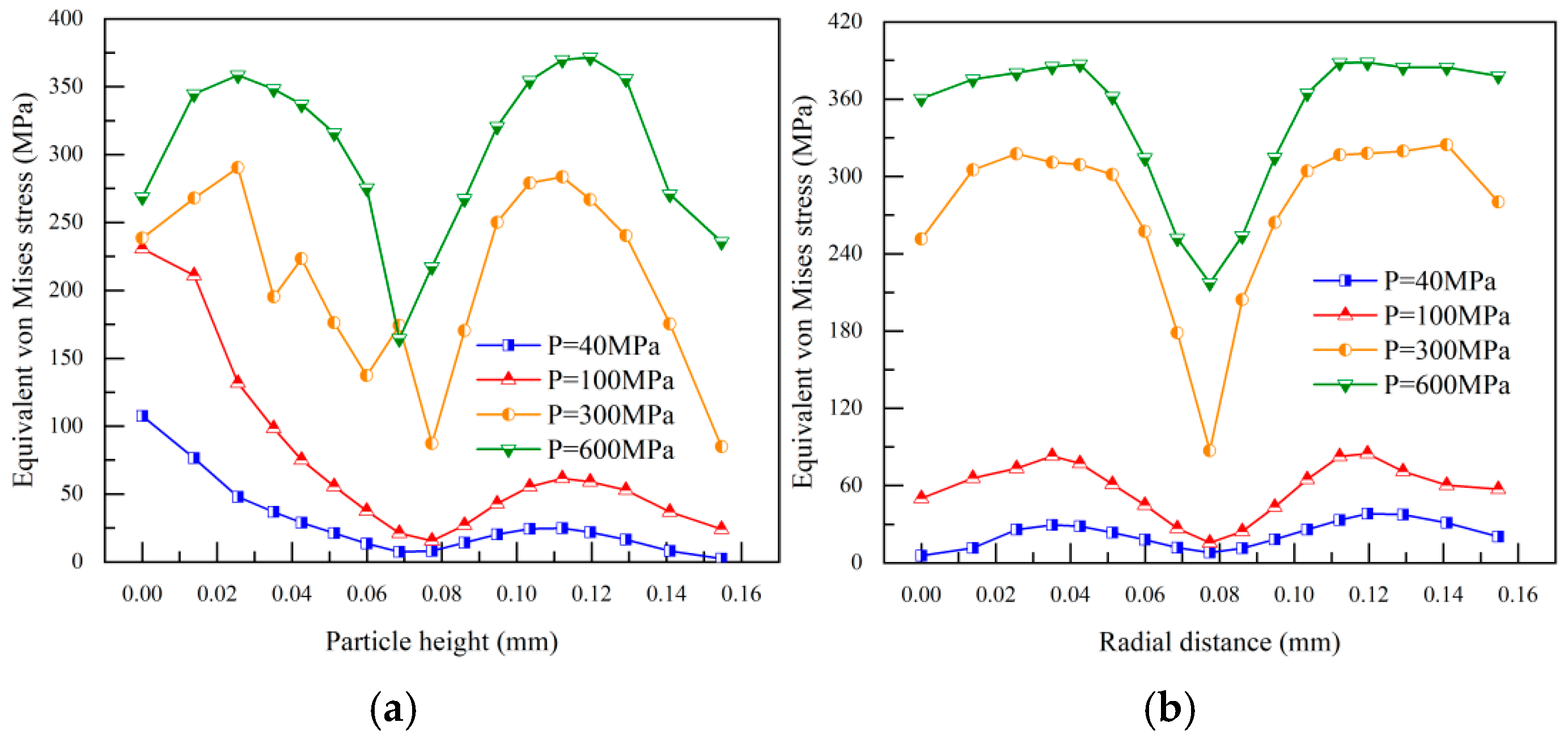
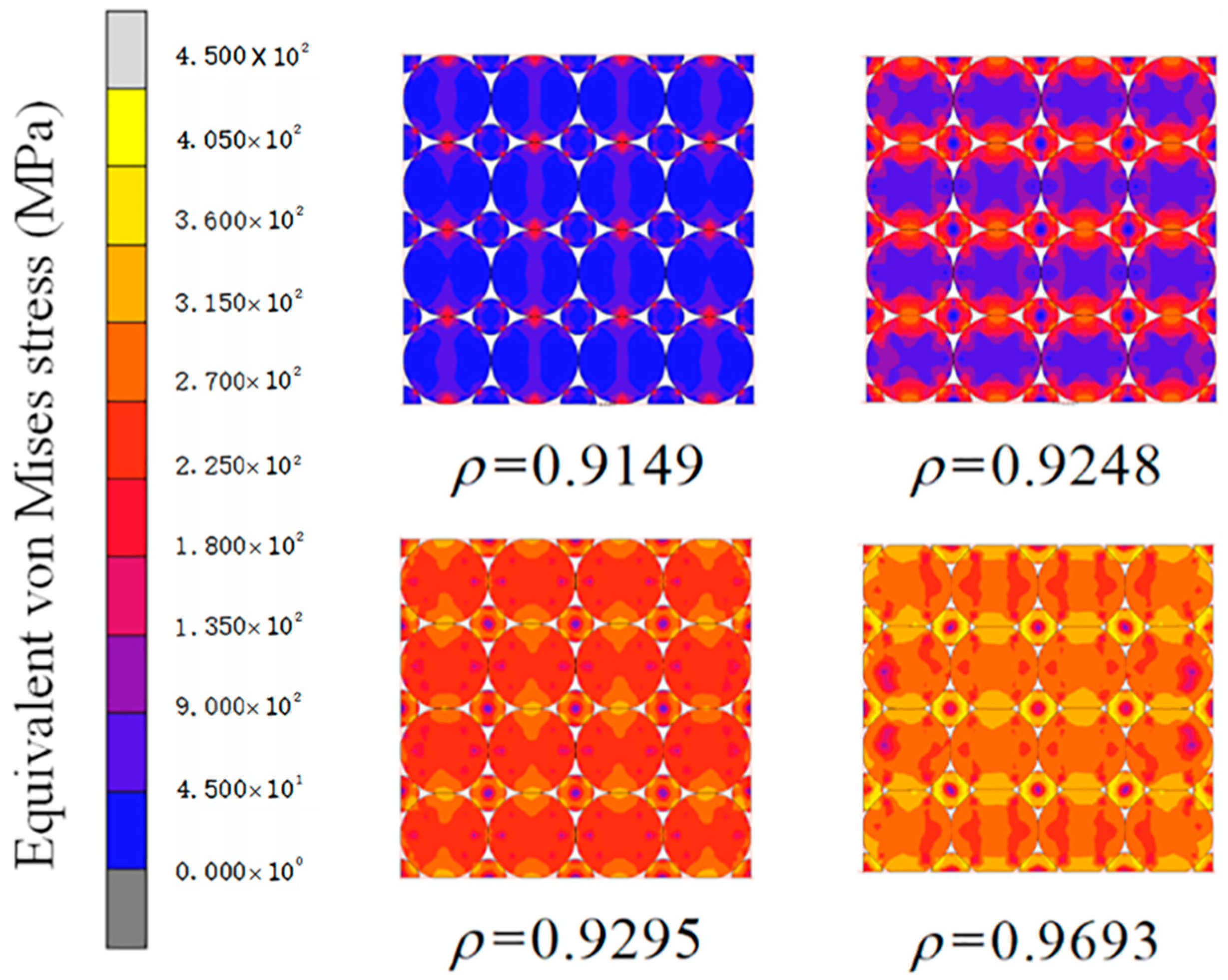
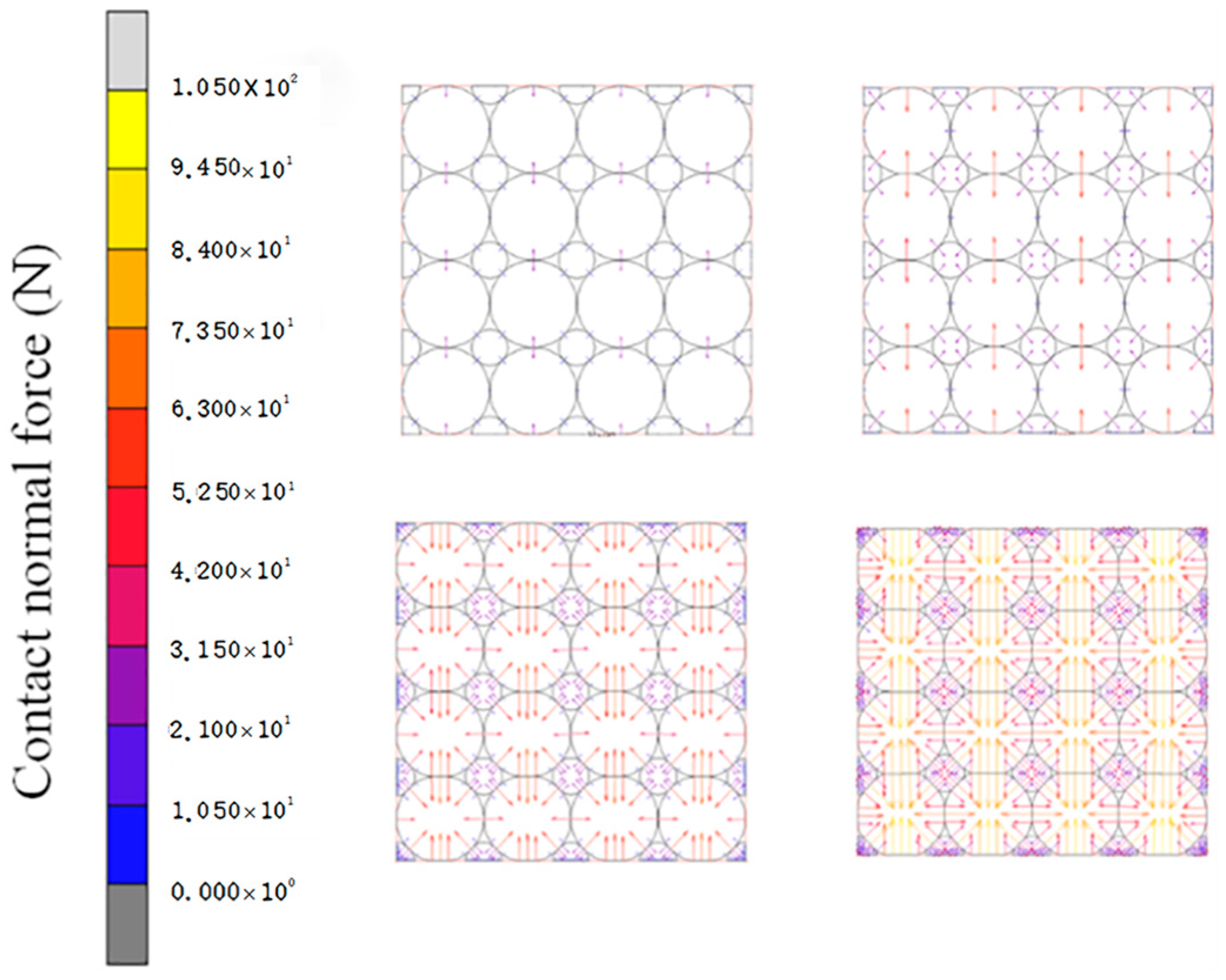
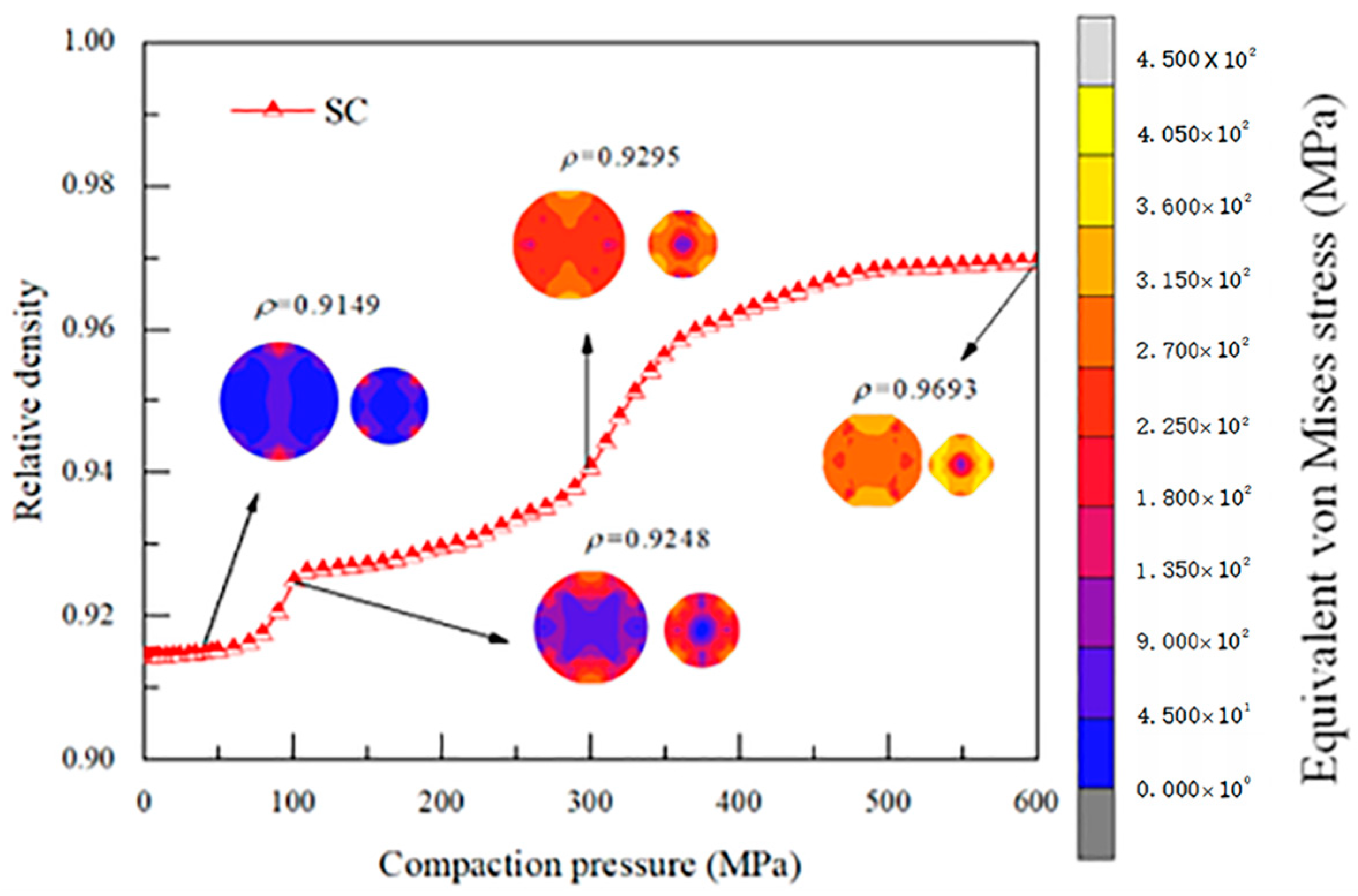
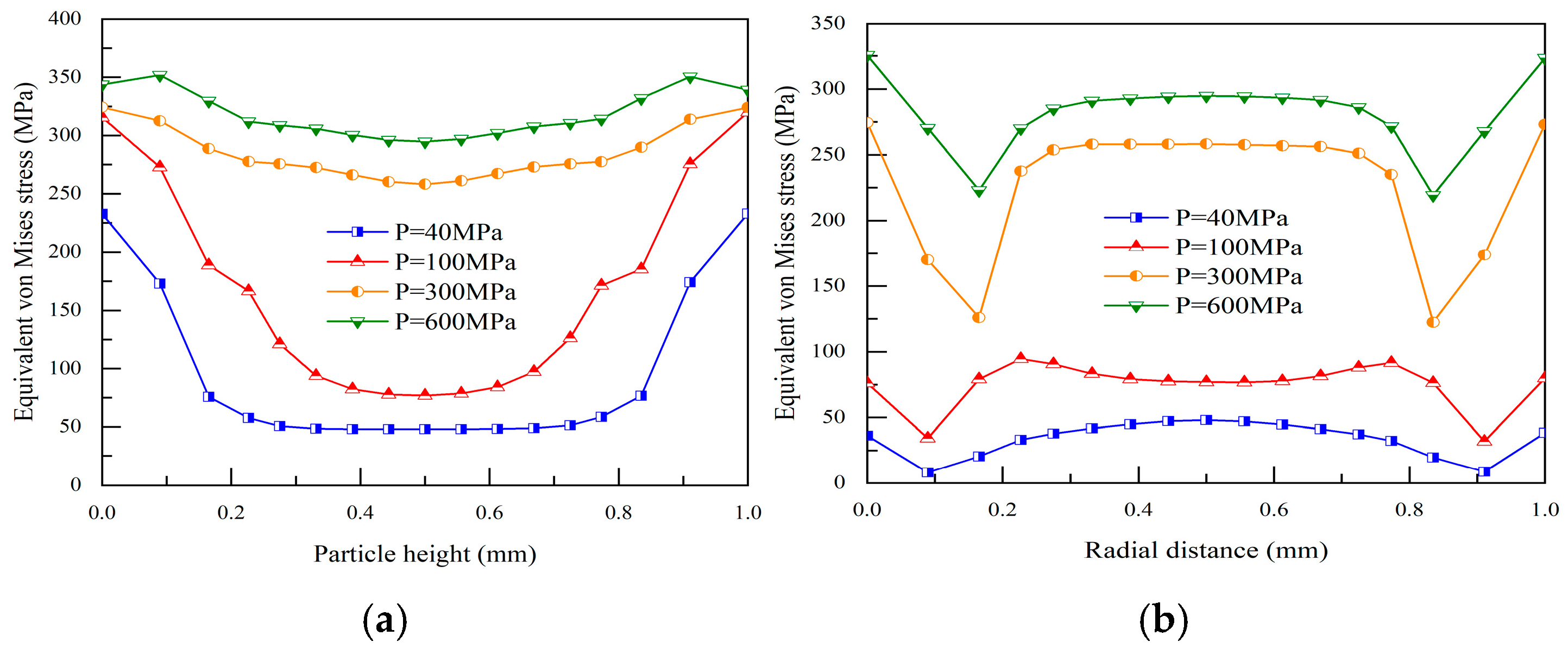
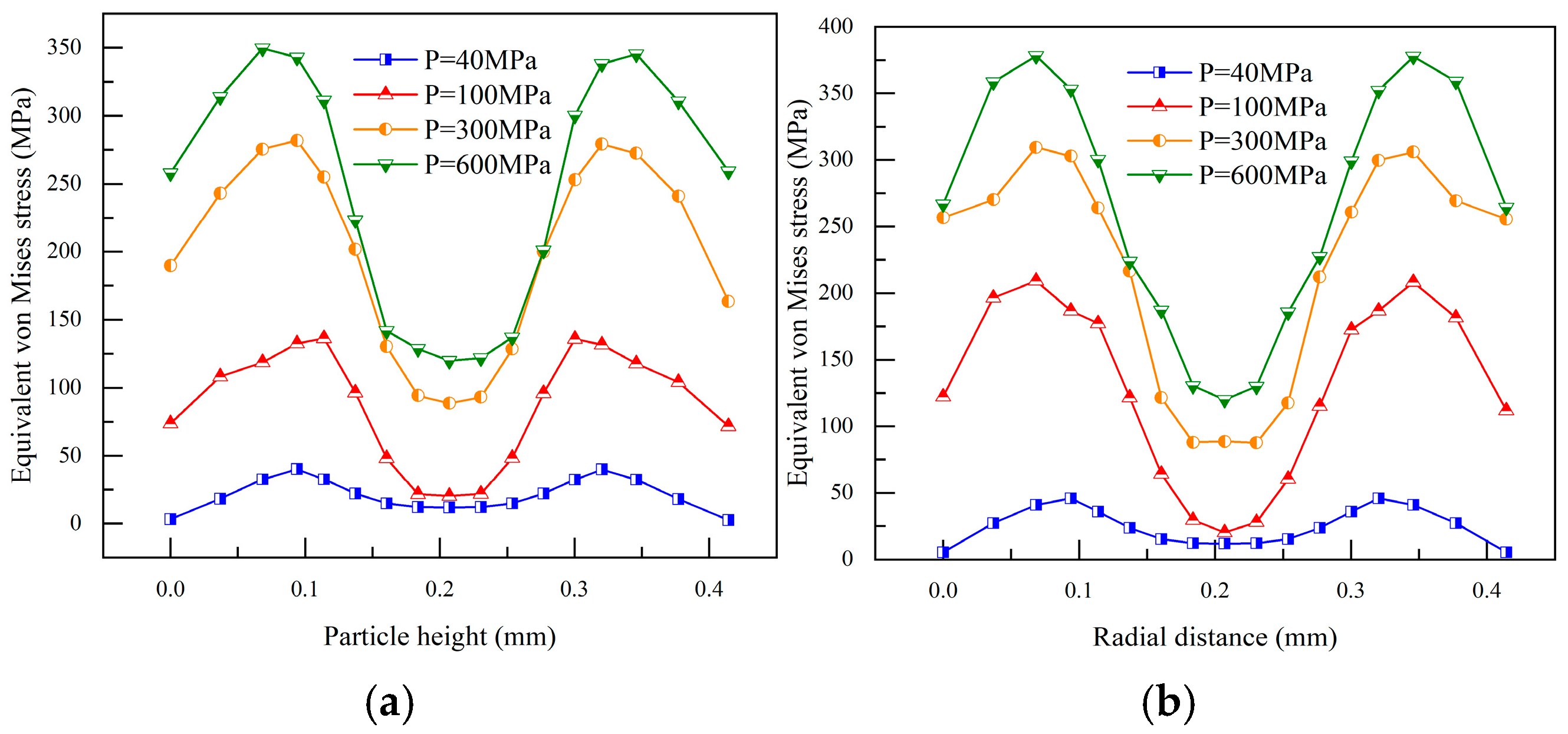
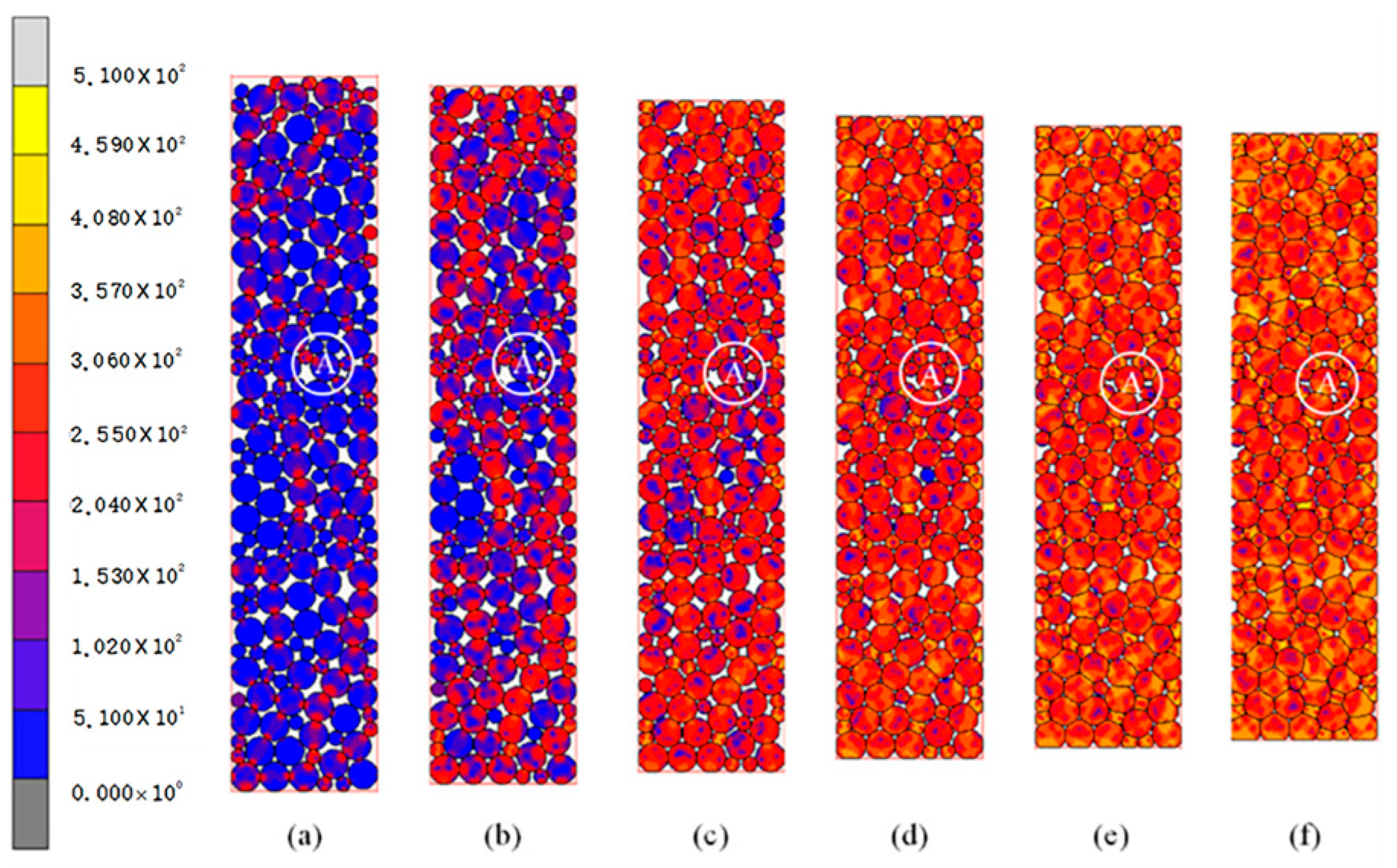
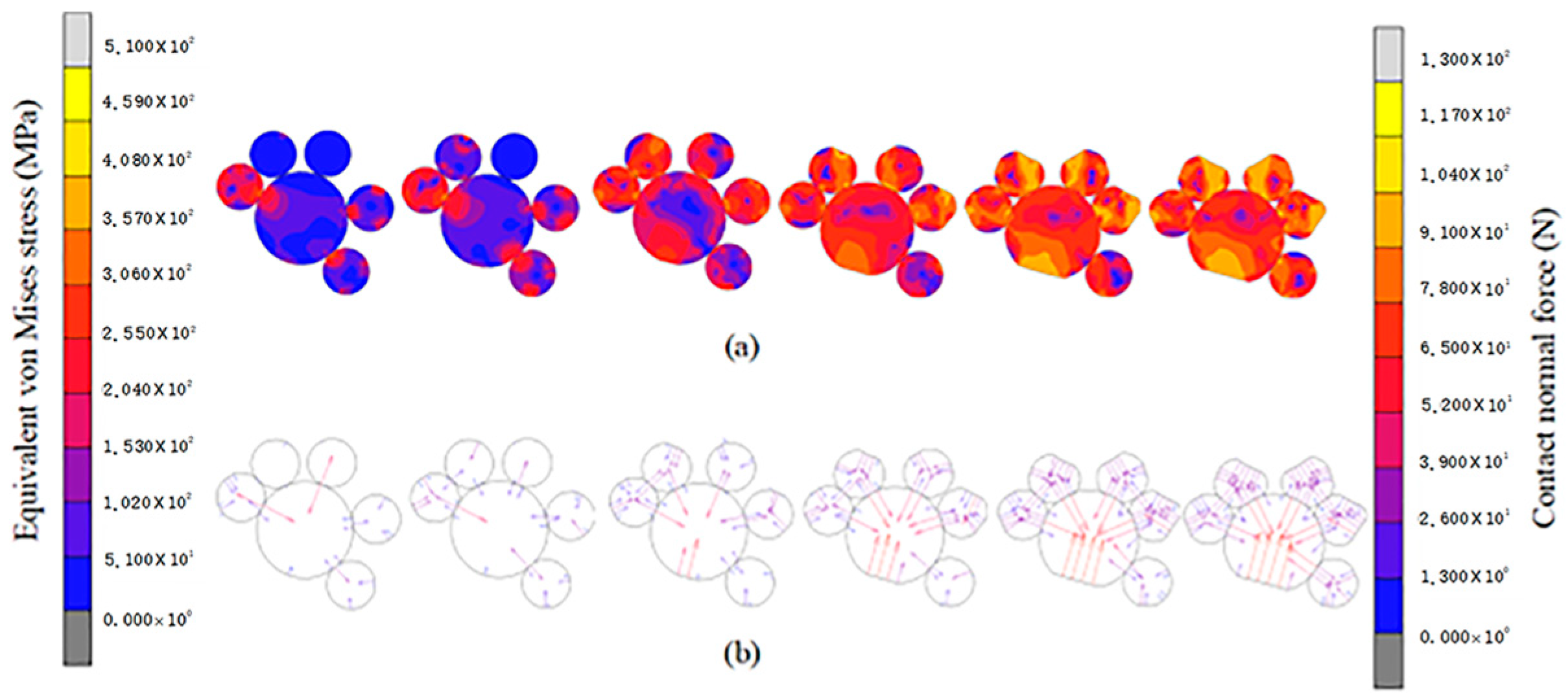
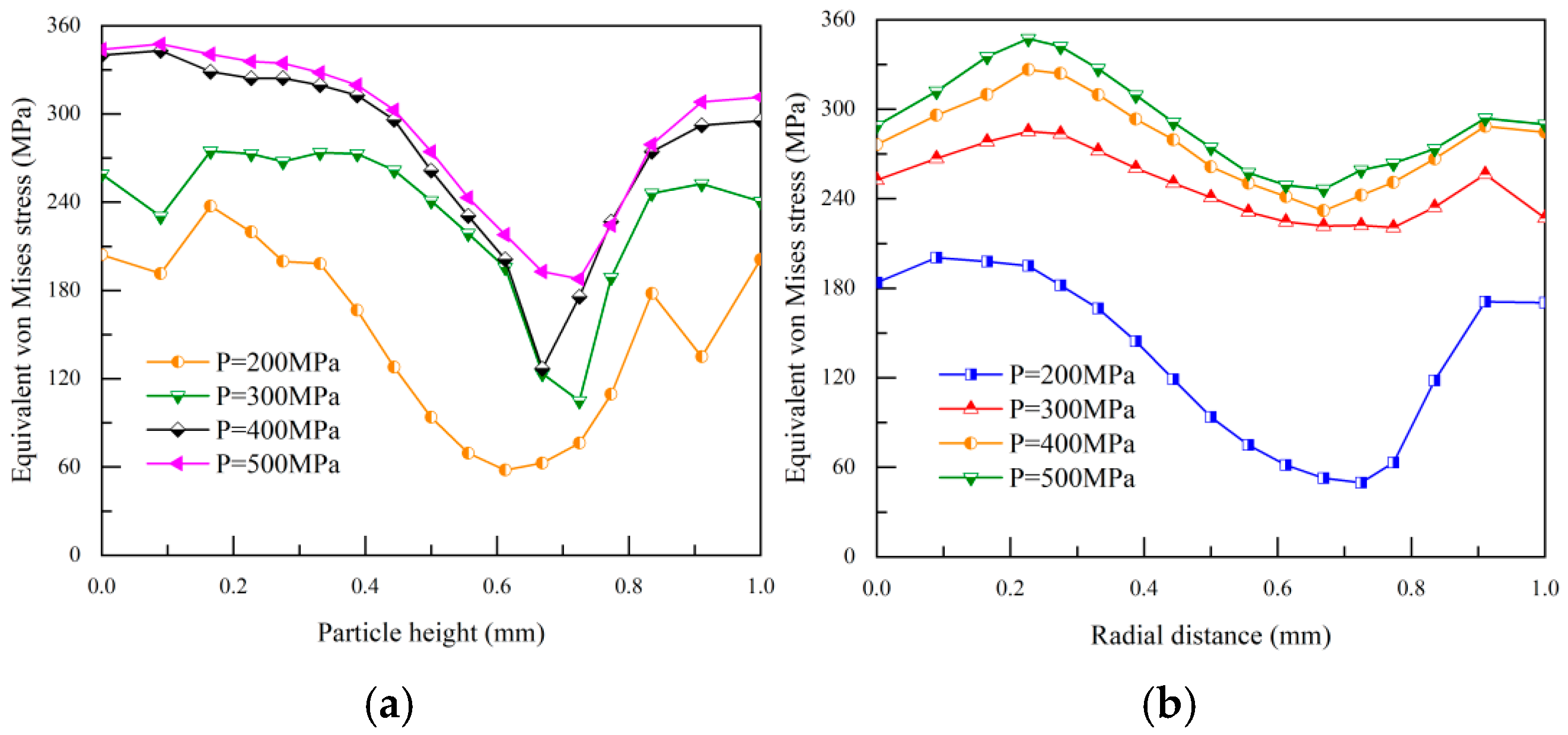
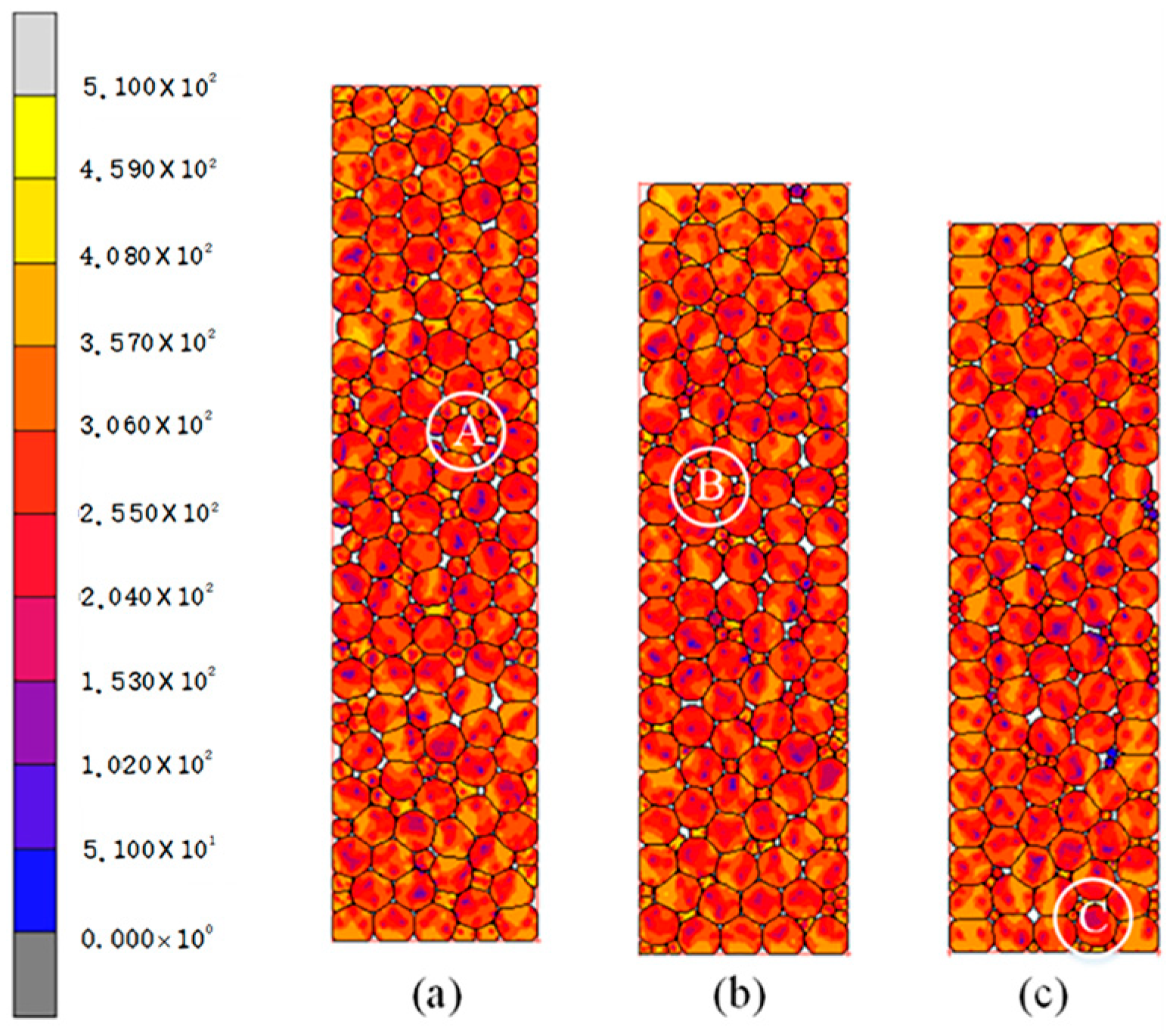
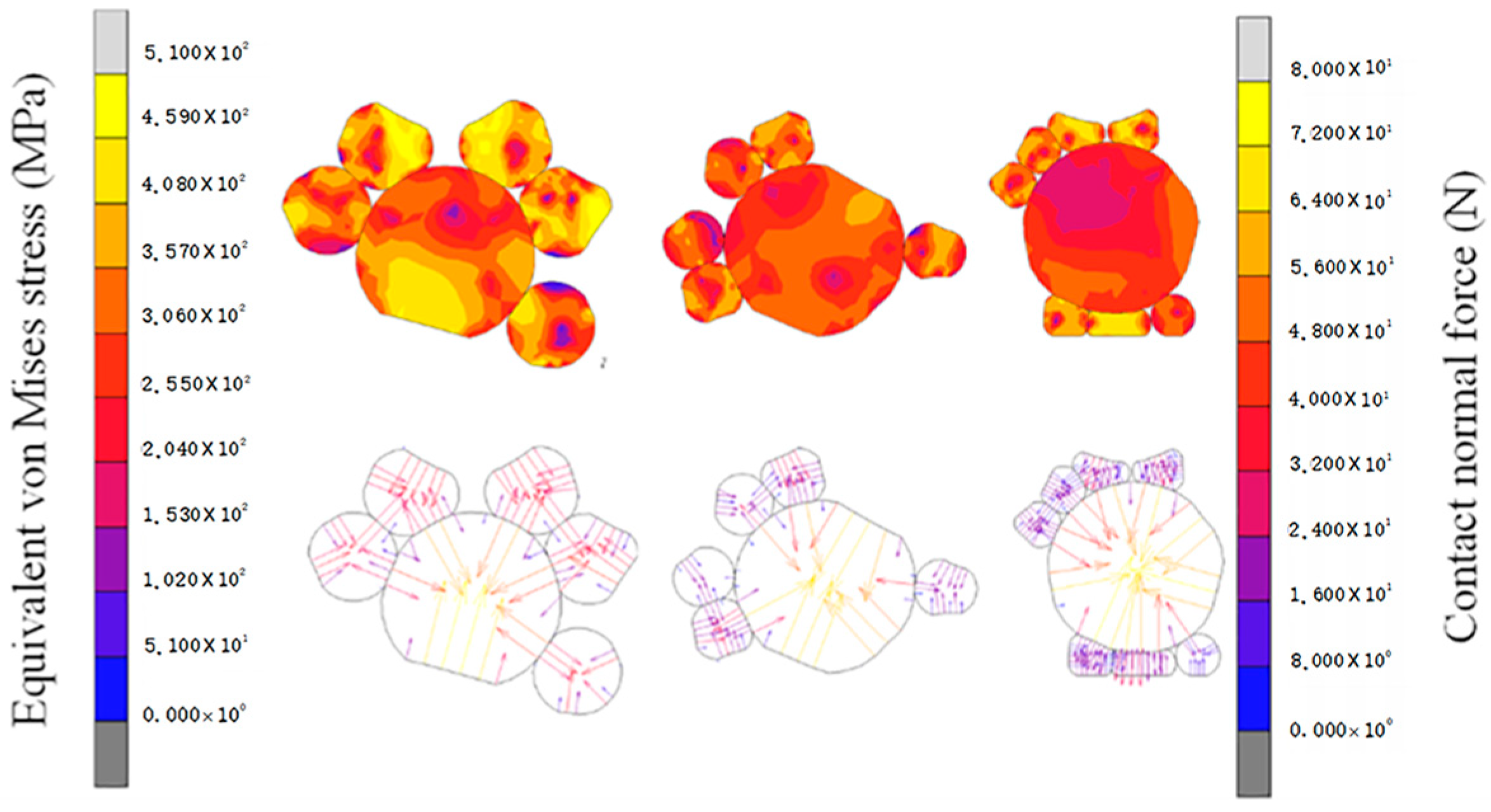
| Stuff | Young’s Modulus E (GPa) | Poisson’s Ratio υ | Strength Factor A (MPa) | Hardening INDEX m |
|---|---|---|---|---|
| Cu | 120 | 0.3 | 448 | 0.126 |
| Initial Stacking Structure | Particle Size Ratio R1:R2 | Number of Large Particles | Number of Small Particles | Initial Relative Density |
|---|---|---|---|---|
| HCP | 16 | 32 | 0.9442 | |
| SC | 16 | 16 | 0.9142 | |
| Random I | 1:2 | 100 | 100 | 0.7806 |
| Random II | 1:3 | 100 | 100 | 0.7913 |
| Random III | 1:4 | 100 | 100 | 0.7925 |
| Ratio | Max Relative Density/Pressure | Stress Distribution | Axial Stress Distribution | Radial Stress Distribution |
|---|---|---|---|---|
| HCP (√2–1:1) | 0.9823/600 MPa | Cu particles of large size: neighboring-layers Cu particles of small size: region of contact with surrounding large particles | Max stress: particle ends Minimum stress: located near the height of 0.3 mm, 0.7 mm, asymmetric distribution | Cu particles of large size: similar to axial Cu particles of small size: the maximum is located near 0.03 and 0.13 and the minimum is in the middle of the particle |
| SC (2√3–3):3 | 0.9693/600 MPa | As above | Max stress: Small gradient at the ends of the particles Minimum stress: symmetrically distributed, large at the ends and small in the middle. | Cu particles of large size: Evenly distributed in the intermediate region Cu particles of small size: symmetrically distributed, large at the ends and small in the middle. |
| 1:2 | 0.9456/600 MPa | Particle contact area | Max stress and Minimum stress: high on both ends and low in the middle | Cu particles of large size and Cu particles of small size: high on both ends and low in the middle |
| 1:3 | 0.9502/600 MPa | As above | As above | As above |
| 1:4 | 0.9507/600 MPa | As above | As above | As above |
Disclaimer/Publisher’s Note: The statements, opinions and data contained in all publications are solely those of the individual author(s) and contributor(s) and not of MDPI and/or the editor(s). MDPI and/or the editor(s) disclaim responsibility for any injury to people or property resulting from any ideas, methods, instructions or products referred to in the content. |
© 2025 by the authors. Licensee MDPI, Basel, Switzerland. This article is an open access article distributed under the terms and conditions of the Creative Commons Attribution (CC BY) license (https://creativecommons.org/licenses/by/4.0/).
Share and Cite
Zhao, Y.; Weng, M.; Wang, W.; Wang, W.; Qi, H.; Li, C. Fixed Particle Size Ratio Pure Copper Metal Powder Molding Fine Simulation Analysis. Crystals 2025, 15, 628. https://doi.org/10.3390/cryst15070628
Zhao Y, Weng M, Wang W, Wang W, Qi H, Li C. Fixed Particle Size Ratio Pure Copper Metal Powder Molding Fine Simulation Analysis. Crystals. 2025; 15(7):628. https://doi.org/10.3390/cryst15070628
Chicago/Turabian StyleZhao, Yuanbo, Mengyao Weng, Wenchao Wang, Wenzhe Wang, Hui Qi, and Chongming Li. 2025. "Fixed Particle Size Ratio Pure Copper Metal Powder Molding Fine Simulation Analysis" Crystals 15, no. 7: 628. https://doi.org/10.3390/cryst15070628
APA StyleZhao, Y., Weng, M., Wang, W., Wang, W., Qi, H., & Li, C. (2025). Fixed Particle Size Ratio Pure Copper Metal Powder Molding Fine Simulation Analysis. Crystals, 15(7), 628. https://doi.org/10.3390/cryst15070628






